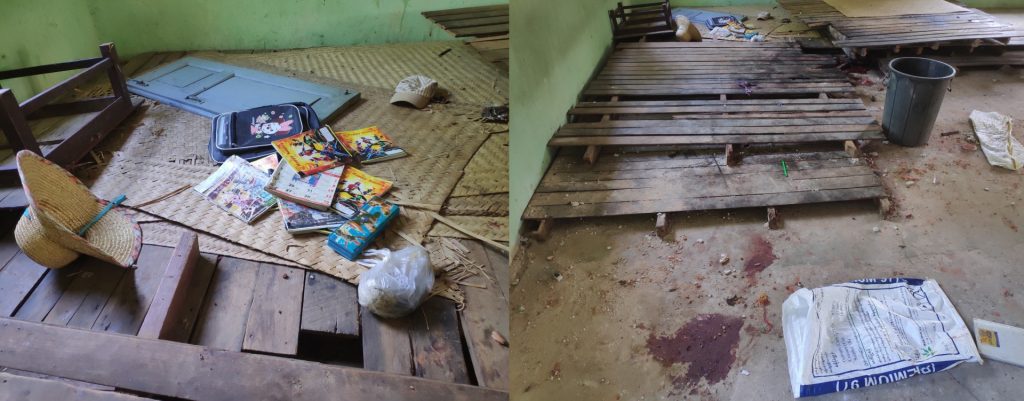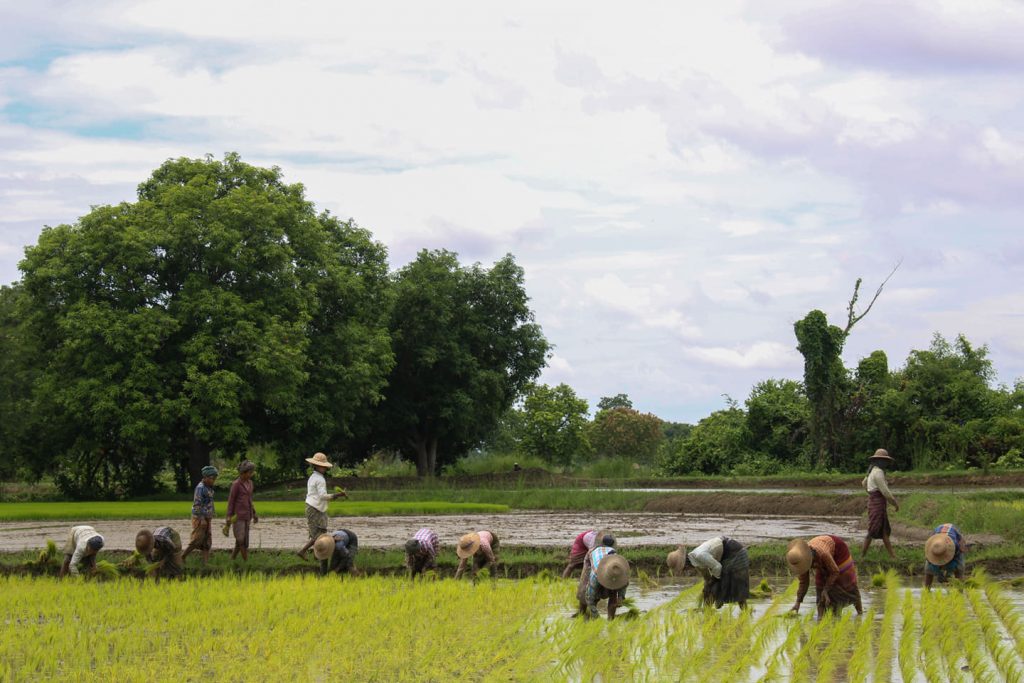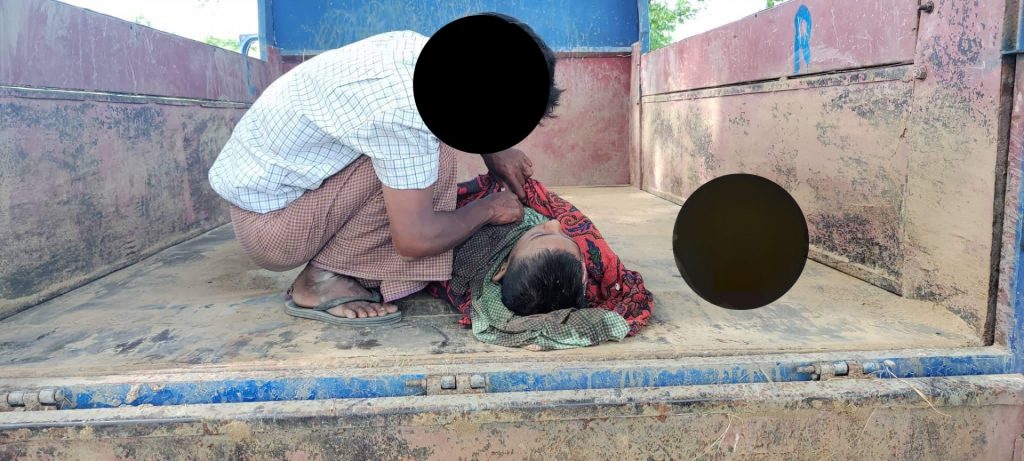Airstrike Epidemic (0) // The junta’s war on children
Lat Yet Kone, Sagaing Region – Early afternoon, the Burmese army intentionally attacked a school and a village in Depayin Township using machine guns and launchers, killing two dozen people, half of them children.
The junta’s troops approached the village in four helicopters. Two helicopters dropped a hundred soldiers on the nearby farms before they attacked the school that is attached to a monastery. They planned to occupy the village by surrounding it, then entering with troops. They came into the village slowly and held hostage or indiscriminately killed those they saw along the way. Six villagers were killed in this rampage. Among them, a man and his 13 year-old son, who were fishing at the dam outside the village, were shot to death. They were not from Lat Yet Kone village but from the village nearby called Kone Gyi.
Another teenage boy died and no one knows where he was killed. The villagers discovered his dead body floating in the tertiary minor dam, marked by clear and recognizable signs of a gunshot wound.
A 33-year-old villager was also killed, near the small bridge at the entry gate of the village. A villager familiar with the situation said that “He was shot in his head. The brain came out of his head. He was killed cruelly on the road. He was a very good person. He volunteered as a social worker in the village. He used to donate stationery and accessories to the school. He always managed to gather donations for the students who were in need. The junta’s troops occupied his house and took 200 lakhs MMK (9500 USD) as well as some jewelry and gold.”
Stealing people’s properties from their houses is a strategy the military use in areas with a large ethnic population for a long time: first they attack by airstrikes followed by ground units, then they destroy the villages and houses, and then they take whatever they want from the houses. For the first time, they implemented the same strategy in the central plains inhabited by the Bamar ethnic majority, including in Lat Yet Kone Village.
The other two helicopters flew directly to the school. Even though 200 students were present at the time and children were studying in the classrooms at about 1 pm, the two helicopters started firing on the compound.

“They shot for one hour. The shooting was nonstop. Two helicopters were shooting; nonstop. It is unthinkable how cruelly they acted towards the children and teachers. It was an inhumane action by the junta’s air force”, said Daw Khat Mar*, who witnessed the horror.
By the time they were attacking the school, a couple was feeding their cows on their farm. They saw the airstrike on the school, which their two daughters were attending. The mother ran directly to the school but she couldn’t reach it in time. She was shot by a big launcher on her way to the school. Her body was split into pieces and she died in the explosion.
Just minutes beforehand, the villagers received information about junta’s troops coming to attack and destroy the village. The teachers arranged to hide the students in safe places but the helicopters arrived earlier than expected. Many of the students were able to flee but some remained exposed. The Sagaing region has geographical limitations that make it difficult to implement safety procedures that would limit the damage attacks would cause. One main issue is that the region’s flat surface makes constructing shelters an unfeasible option as bunkers need to be in areas in which they can be hidden underground.
The situation in the classroom became horrifying after the attack started. All the rooms were full of the sounds of children crying, shouting, and murmuring. These sounds were reactions to the sight of people being shot and wounded. The school roofs were destroyed. The walls were damaged, pieces were falling down, and the rooms were full of smoke. Many of the desks and school bags were stained with blood. Some children were dying after losing body parts and organs. Others were crawling out of the smoky room without legs. One child died with his abdominal split open. Another student lost his sight.
After the military seized fire from the airstrike, ground soldiers came into the school compound and shot at any sort of resistance. They also arrested some villagers and brought them as hostages. They made them kneel on the ground with their head down. They threatened them that if someone dared to look up, they would shoot them in the head.

The soldiers targeted the school because some local families who held pro-junta sentiments told them that there would be a gathering of local People’s Defence Forces (PDFs) in the compound on this day. So they ordered the people in the classroom to come out. This did not happen as they expected because the people who came out from the smoky rooms were not PDF soldiers but they were students and volunteer teachers. Small children came out of the classrooms scared and shaken with injured, bloody bodies.
Among them, a six-year-old boy was the most injured. He lost his arm and his male organ. The child cried for his mother. One of the hostages turned out to be the boy’s mother. She was brought to the school compound. When she heard her son’s voice, she was permitted to bring her son out of the school. When she came out, she brought out her son’s bloody body. At that time the child couldn’t withstand the pain. His last words were:
Mom, I can’t resist these pains. Kill me, please
This is a memorable statement about this miserable tragedy in Myanmar. Within minutes, the child passed away in his mother’s arms.
The soldier didn’t allow the mother to arrange the funeral of her own son. The same is true for all other dead bodies. “The mother asked for her son’s dead body in order to bury him. That was her only wish and she begged the soldiers, but they said that they did not have permission from the center to allow her to do this. No one was given a chance to do a funeral for the dead bodies of children. The soldiers brought out all the dead bodies from the school in an inhumane way. All dead bodies and body parts were put into bags which we use for packing rice and crops”, said Daw Win Mar.
After the soldiers occupied the school compound and didn’t see any PDFs as they expected, they recognized the atrocity they had committed. One of them murmured, “Oh my god, children? We were wrong, it is wrong”. Some of the villagers heard about the incident and about the soldier’s reaction. They said that the leader of the soldiers apologized for their actions. The military official said that “What they did in this mission is not what they wanted to do, but they got a report that the PDFs were holding the meeting in school. That’s why they shot at the school but it was wrong information”.
One man, who was an eyewitness, said that “How dare they say, “they were wrong” after they attacked using machine guns and bombs from helicopters. If we can absolve our actions by only saying the word ‘We were wrong’; we want to say it after we did the same things to their children. Children, who were learning, were attacked by an airstrike, and then the attackers said only one word for an apology; we also want to do the same things to their children and we will apologize by saying that we were wrong.” Another man said that “It is unthinkable that they didn’t know whether PDFs were in the classrooms or not.”

In addition to the deaths at the school and in the village, about ten children and adults were injured. The soldiers brought them to their base, which was in Ye Oo City, where a military clinic is located. After they left the village, they took two villagers as hostages because they were worried for their safety on their way back to their base. The two hostages, one teacher and one villager, were accused of being members of the PDF. The military claimed that if there was an ambush or land mine explosion on the road, they would kill one of the hostages, according to local source Ko Thu Ta*.
There was no retaliation attack by local guerillas but the soldiers killed the hostage villager before they reached Ye Oo City anyway. They threw his dead body on the road and no one dared to take it away that day. Ko Thu Ta said that on the next day when they took the dead body away, it was extremely damaged.
Ko Thu Ta is a villager from Lat Yet Kone. When the school was attacked by the airstrike, he was hiding with his parents in their house. But his 7-year-old younger brother was at school. Staying put was the only thing they could do and their main priority was their survival as they thought their son and brother already died. “We thought that we had lost our brother because it seemed that no one could escape the terrible air strikes. We could not do anything for him. We could only try to control our emotional state”. Despite the heavy airstrike, his brother escaped death, but he witnessed the horrible tragedies of that day. He saw the room where his friends were dying, with their shapeless bodies split into pieces. Ko Thu Ta worries that this horrendous experience will make his brother and other students sick, both mentally and psychologically.
This tragedy stopped their learning process. Whenever they hear the sound of helicopters and fighter jets, they are scared and traumatized. Some children now have nightmares and wake up all the time. Even adults are afraid of dying. Some families left the village and moved to other places.
Ko Thu Ta
The injured people who were taken to the military clinic were not allowed to call their relatives to ask them to take care of them. The two drivers, who transported the patients to Ye Oo City, were arrested and taken hostage for one week. Then, the drivers were released, but the patients were not released. All patients were hospitalized for weeks in the military clinic and on October 25th, they were finally allowed to go back to their village. Before that, at least two minors were forced to read out scripted “testimonies” of what happened on camera for propaganda purposes, according to the National Unity Government (NUG).
However, a 15-year-old boy was still in serious condition so he was transferred to the Pyin Oo Lwin Military hospital. They allowed him to call one relative to take care of him and his mother came. His condition was not improving, therefore, they transferred him to the Nay Pyi Taw Hospital with an army vehicle. But on the way, the car was hit by a mine explosion and his mother who came to take care of her injured son sustained a head injury. It was a never-ending sad story for their family according to Ko Thu Ta, who doesn’t know how many soldiers were injured or died in this event.
Attacking schools and hospitals break International Human Rights laws. Crime against children is one of the six highest and most heinous crimes recognized by United Nations’ statutes as children are considered especially vulnerable due to their inability to make rational decisions when trapped in full-scale war. In the first six months after a junta led by General Min Aung Hlaing seized power, 75 children deaths have been reported due to the ongoing conflict. More than half a million children were forced to flee and hundreds of children have been detained since the coup.
On September 20th, 2022, international organizations and the general secretary of the UN, Antonio Guterres spoke out. Their statements strongly condemned the actions of the junta’s troops and expressed their condolences and sympathy with the families who lost their children. The international embassies in Myanmar demanded that the junta takes responsibility for those terrorist actions and stops any further violation of international law.
The spokesperson of the junta regime, General Zaw Min Tun reiterated in a press conference on the same day that “According to our information, the KIA (Kachin Independence Army) and local PDF were there, that’s why they attacked them.”
Sagaing Region is one of the strongest hotspots of resistance fighting against the junta’s troops since the coup. As daily clashes between Burmese army and PDF are recorded for a year in the area, the tragedy of Lat Yet Kone is only reinforcing the local opposition to the illegitimate military regime.
Airstrikes Epidemic (I) // Open wounds in the heart of Kachinland
Airstrikes Epidemic (I) // “Each time I ran from place to place, I got further and further away from home.”
Airtrikes Epidemic (II) // “Not every house has a bomb shelter yet”
OUR RELATED WORK PUBLISHED ON DEMOCRATIC VOICE OF BURMA (DVB)
The child victims of Myanmar’s military coup